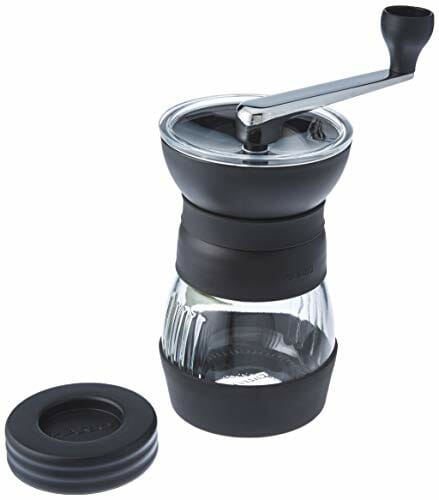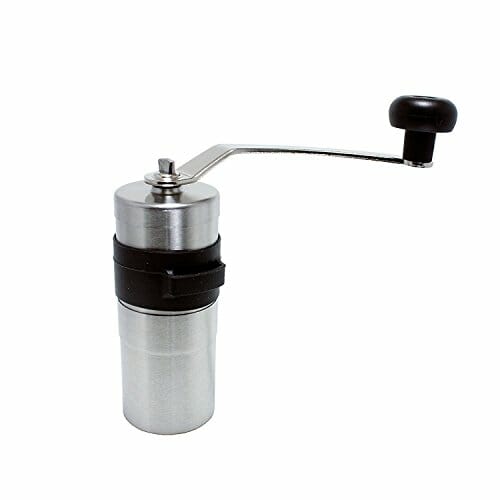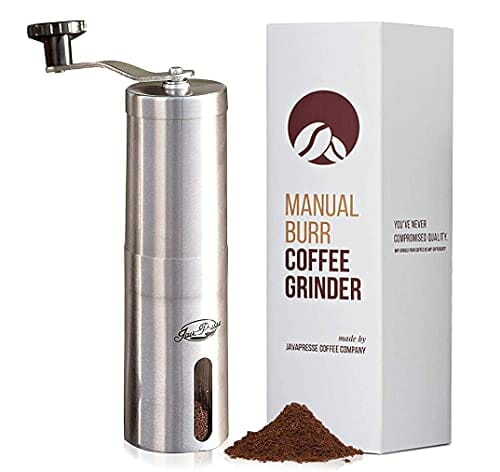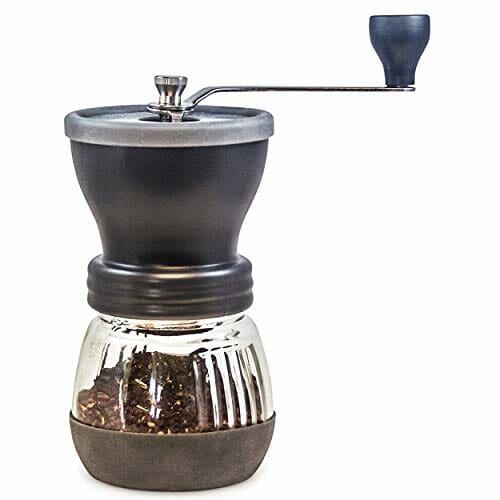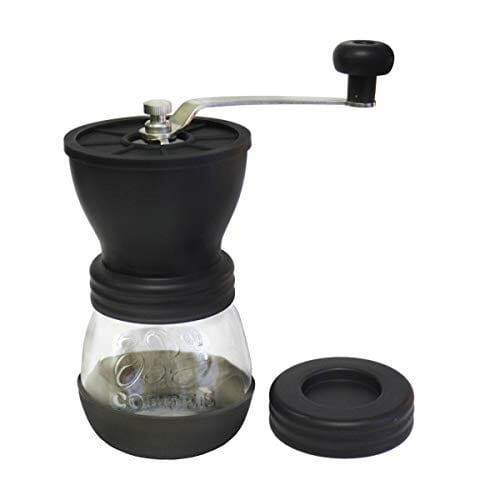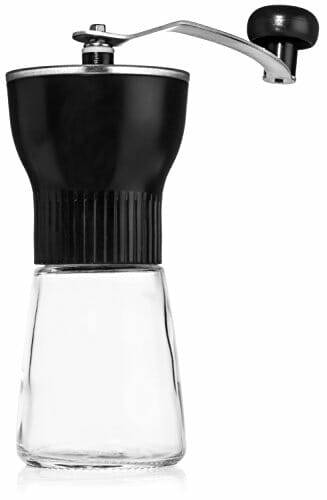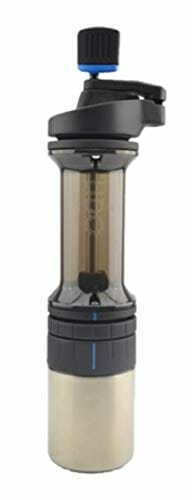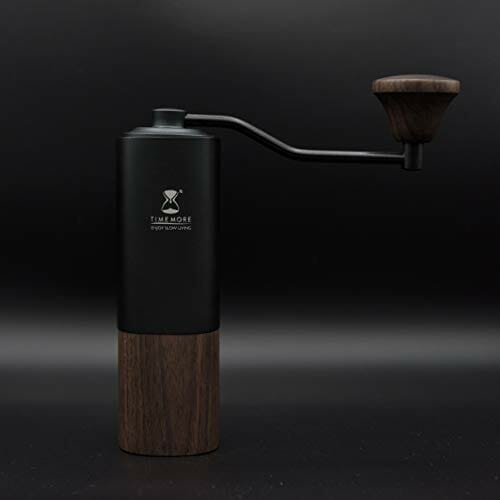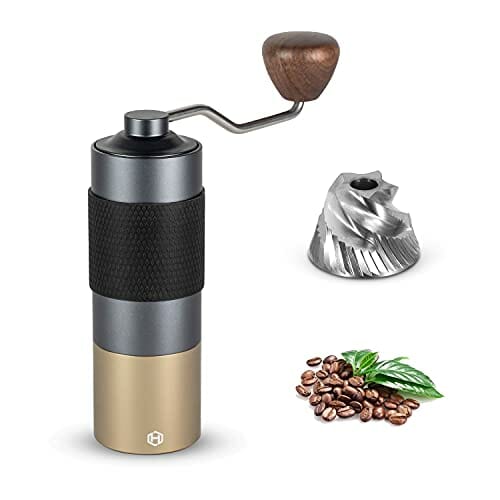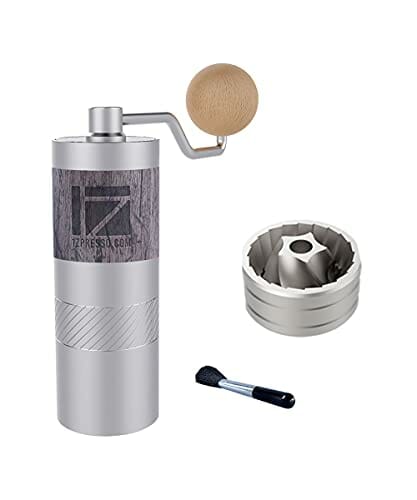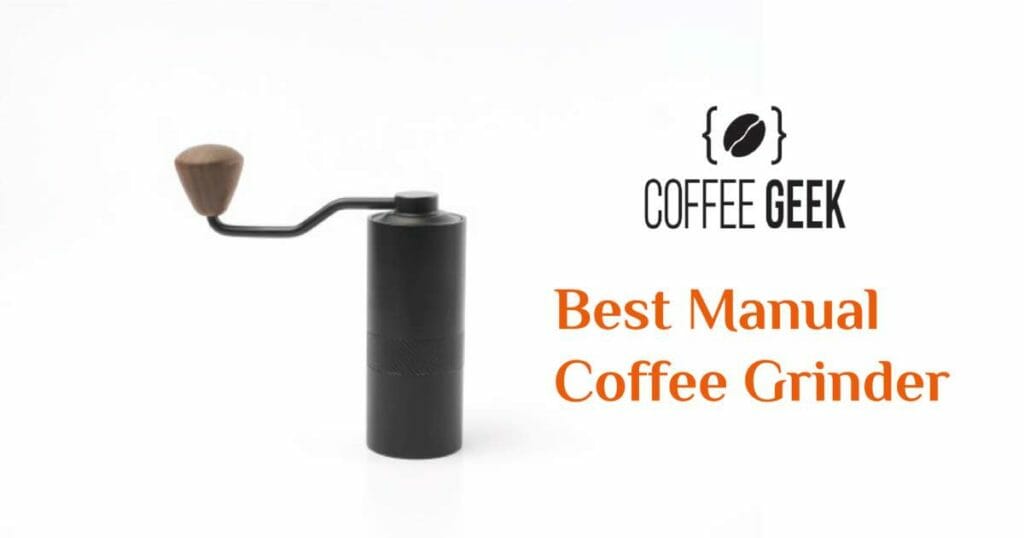
I love to grind my own coffee beans for a fresh cup of coffee. Fresh is always better, plus that aroma flowing through the kitchen awakes all my senses.
From a practical point of view, you get more flavors and natural oils out, and you can control the grind size. Freshly ground coffee, brewed straight away also tastes crisp, and way better.
If you’re like me, then you wouldn’t settle unless you have the best manual coffee grinder that’s available that fits all the right criteria like price, consistent grind size, easy maintenance amongst many others
In this article, I’m going to make your manual brew life easy by running down the hand coffee grinders that are available and take the guesswork out which is the best to chose.
There’s a big element of consideration when choosing your ideal manual coffee grinder but we’ll touch on that later. For now, let’s cover of some fundamentals on why freshly ground coffee is better.
The Best Manual Coffee Grinders – Comparison & Guide
| Hand Grinder | Product | Features | Price |
|---|---|---|---|
Editor's Choice  |
| CHECK PRICE | |
 |
| CHECK PRICE | |
Light & Compact  |
| CHECK PRICE | |
 |
| CHECK PRICE | |
 |
| CHECK PRICE | |
 |
| CHECK PRICE | |
Vintage Look  |
| CHECK PRICE | |
 |
| CHECK PRICE | |
 |
| CHECK PRICE | |
 |
| CHECK PRICE | |
 |
| CHECK PRICE | |
 |
| CHECK PRICE | |
 |
| CHECK PRICE |
Why Is Freshly Ground Coffee Better?
- If you buy a pack of pre-ground coffee, you never know if previously mentioned factors: time, oxidation, moisture, heat, or CO2 depletion did not do a job on it already.
- You also do not know the purity, quality, color, aroma, and flavor of the coffee.
- If you buy more coffee than you can use, chances are that it will end up in the bin. The unopened bag of coffee can last for 3-5 months in the pantry. Open one is good-to-drink for the first two weeks, then the quality goes down. Whole coffee beans last for 6 months.
- With pre-ground coffee, you do not have power over the grind size, and you are limited to certain brewing methods. Just an example: If you buy beans, you can make ⅓ of them into a fine-coarse (good for espresso), ⅓ into a medium-coarse grind (for the pour over brewing method), and ⅓ into a coarse grind (French Press)
- Once you open a pack, it can get easily contaminated by other smells in your cupboard or pantry. PS: Never ever store ground coffee in the fridge.
- Talking about packaging — you help the environment more if you buy coffee beans.
- And my last point on why is freshly ground coffee better? You can buy a nice coffee grinder! But which one?
What Are The Best Manual Coffee Grinders?
There are two main types of coffee grinders: blade coffee grinders and burr coffee grinders. Most of the coffee aficionados swear by burr coffee grinders. Why? Look at my comparison:
Blade grinder
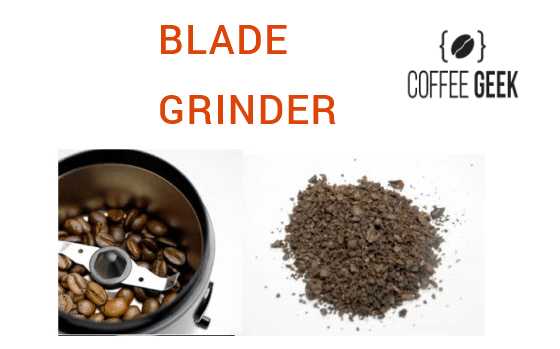
- rotating blades produce uneven pieces
- grinding creates heat and as I wrote before, heat is not our friend during the grinding process
- cheaper than burr coffee grinders but do not get fooled by the price. Go for quality!
Burr grinder
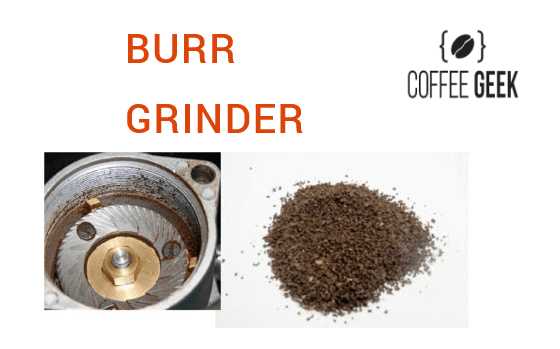
- produces uniform grind thanks to two burrs that sit inside another
- grinds beans more gently, at a lower speed, thanks to rotation and lower RPM (turns in a minute)
- more expensive but it is a return on investment
I would like to advise you to invest in a burr grinder. There are two types of burr coffee grinders, flat plate, and conical ones.
The flat plate burr grinder has two identical and parallel rings, while the conical burr grinder has two coned-shaped burrs. Both of them have one burr that does not move while your hand serves as the motor and turns the other one.
In general, flat plate burr grinders are more expensive and heat up faster. Conical burr grinders are quieter and cheaper.
The price of a burr grinder depends on its type, manufacturer, size, and material used for the body and burrs. Ceramic burrs are sharper, absorb less heat during the grinding process, but they are more fragile.
I prefer manual coffee grinders as they do not generate as much heat as electric grinders. They are less noisy and cheaper, too.
Later in the article, I will look closely at the 13 best manual coffee grinders sold on Amazon so you can make the right purchasing choice.
Where To Buy A Manual Coffee Grinder?
I will have the same advice as I presented in my article about pour-over coffee makers.
You can buy a good coffee grinder online (my favorite place is Amazon), or a specialized shop selling coffee gadgets and equipment.
General electric stores or non-specialized shops might have only cheaper models, electric grinders, or blade grinders.
Factors that you can keep in mind when finding the best manual coffee grinder:
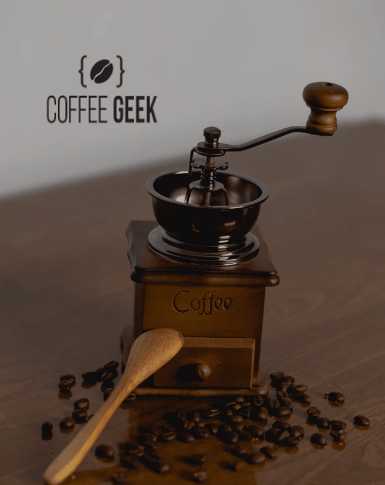
- Size and shape — Some coffee grinders are heavier or go for an antique look. If you want something compact and easy to grip, go for a slim size, and a conical shape.
- Your coffee demand — If you want to make 1-2 coffees, a hopper with a 20g capacity is ok. Go for a 40g capacity for 2-3 cups of coffee, 85g for 3-4 coffees per grind, and 100g for 4 and more. The bigger the capacity, the stronger your arm will be :)
- Material — I would recommend ceramic burrs if you will be careful, use the grinder only at home, and not travel with it for example. They do not go dull easily and do not rust. And the outer design? There are minimalistic, wooden, metal, lightweight ones… Up to you.
- Settings — As I said before, you turn the ring clockwise for a finer grind and counterclockwise for a coarser grind. Always follow the manual. With many coffee grinders, you can tell by clicks, that feel like bumps. Grinders that have a grinder setting dial (numbering) make achieving the same results easier.
- And of course, price.
Which Coffee Grinder Is The Best?
1. Hario Skerton Ceramic Coffee Mill
Weight : 1.25 pounds
Material : Glass body. Rubber non-slip base. The lid, grip, and hopper are made of plastic.
Burrs : Ceramic conical burrs
Capacity : 100g (more than 4 coffees per grind)
Grind settings : Stepped grind adjustment mechanism. 4 clicks for espresso, 7-9 for drip, 12-16 for Cold brew
Good for : It is best for espresso-kind of grind
User-friendliness : With its ergonomic but nice design, it will sit well in the kitchen. It is not travel-friendly, as it is heavier and made from glass.
Hario Skerton is easy to use and clean, screws on a mason jar, plus with Hario being an established company, you should not have issues finding spare parts, shall you need them.
2. 1Zpresso Q2 Manual Coffee Grinder Mini Slim Travel Sized
Weight : 1.17 pounds
Material : Premium, resilient materials such as stainless steel, alloy, polycarbonate. Anti-slip leather on the main body. The curved handle lever is easy to rotate, and on the top sits a wooden knob.
Burrs : Stainless steel burrs. Do not clean this coffee grinder with water, only a dry brush and blower. It prevents deterioration through rust.
Capacity : 20g (1-2 coffees per grind)
Grind settings : There are 10 numbers on the dial which means
30 clicks for a full 360 turn. Rotate clockwise for fine grind or counterclockwise for a coarser grind. Approx. 1.5-2.5 clicks for filter coffee, 2.5-3 clicks for French Press.
Good for : Not suitable for espresso. It was designed for the pour over method or Aeropress.
User-friendliness : This tiny, travel-friendly coffee grinder is light and easy to use.
However, if you want to grind more beans at the same time, it is not for you. This coffee grinder is loved for the fact that it fits perfectly in the plunger of AeroPress and it generates consistent grind, fast.
3. Porlex Mini Stainless Steel Coffee Grinder
Weight : 0.5 pounds
Material : Stainless steel, static-free body, rubber grip. The guide on the top and the nut that holds the porcelain grinder pieces inside are plastic. Ceramic conical burrs
Capacity : 20g (1-2 coffees per grind)
Grind settings : Turn the wheel clockwise for a finer grind and counterclockwise for a coarse grade. When you turn it clockwise and it stops — this is the finest grind.
Do not tighten it too much, since the ceramic burrs will get stuck. If that happens, the handle will not turn. In that case, just move the adjusting wheel to the point where the handle can be turned again.
This point is considered the finest grade setting (1-2 clicks.) For a medium, go for 7-8 clicks; for course, 11-12 clicks. Print a coffee grind chart, there are many online, and test it on a small number of beans.
Good for: Not suitable for espresso. It was designed for a medium-coarse grind. Suitable for French Press or Turkish coffee.
User-friendliness: This minimalistic coffee grinder made in Japan is even lighter than the previous one and its burrs are sharp and static-free. Make sure you are buying the updated version – with a redesigned handle and more robust crankshaft.
It fits the Aeropress plunge, too. Instructions are in Japanese, but with a bit of Googling, you can find English instructions for Porlex Mini online.
If you would like to avoid changing spare parts in two-three years, avoid Porlex, as it has some plastic parts, and there are cheaper portable coffee grinders on the market.
4. JavaPresse Manual Coffee Grinder with Adjustable Setting
Weight : 0.6 pounds
Material : Grade 304 stainless steel body. Ceramic conical burrs
Capacity : 40g (2-3 coffees per grind)
Grind settings : 15-18 settings that might be hard to get used to at first because there are no “clicks” you just have to feel it and anticipate them.
The closer the burrs, the finer the grind. 1-3 “clicks” will get you an extra-fine grind, 4-6 medium fine, 7-9 medium, 10-12 medium-coarse, and 13-18 coarse grind.
You can try 1 click for Turkish, 2-4 for espresso, 8-10 for drip coffee, 14-16 for French Press, and 14-18 for Cold brew.
Good for : Espresso, Moka, pour over, Chemex, French Press, you name it.
User-friendliness: Another functional and portable coffee grinder that fits inside the Aeropress. And an affordable one, too!
However, if you want to grind more beans at the same time, or do not want to work for it (it takes up to 5 minutes), go for another manual coffee grinder (for example the glass Hario Skerton), or one of the electric grinders.
I must say I like Javapresse for their social responsibility. The company supports farmers in Colombia and Guatemala.
5. Khaw-Fee HG1B Manual Coffee Grinder
Weight : 0.62 pounds
Material : Glass jar, rubber top, silicone base. The body and knob are plastic. The parts inside are stainless steel and ceramic. Ceramic conical burrs
Capacity : 1 coffee per grind
Grind settings : Built-in adjustable grind selector. To adjust it, take the handle off. You will see the screw. If you turn it, the burr will open. The more you tighten it, the finer the grind. Put the parts together, then the handle and you can grind away.
Good for : French Press, pour over, espresso, Turkish or regular drip coffee.
User-friendliness : This coffee grinder by a less-known family-owned company is offered with a 100% Lifetime No Questions Asked Warranty.
It is cheap, yet the parts inside it are not plastic, which makes it a good buy. Yes, the jar is made from glass but even if you break it by accident, a replacement one costs less than 8 dollars.
6. Manual Ceramic Hand-crank Coffee Mill by Kuissential
Weight : 1.35 pounds
Material : Glass jar, non-slip BPA-free base, and a lid. Ceramic conical burrs
Capacity : 25-30g (2 coffees per grind)
Grind settings : Built-in adjustable grind selector. To adjust it, take the handle off. You will see the screw. If you turn it, the burr will open.
The more you tighten it, the finer the grind. Put the parts together, then the handle and you can grind away.
Good for : Any coffee, from fine espresso to medium coarse coffees. Not recommended for a coarser grind.
Remove the top nut, locking ring, and the handle. Hold the central shaft and turn the adjust ring clockwise for a finer grind, and counter-clockwise for coarse.
If you loosen it 1-1.5 turns it will be a medium grind. And if you loosen it 1.5-2 turns it will be a Coarse grind. Always test your setting with a few cranks of the handle.
User-friendliness : Kuissential is similar to the previous coffee grinder, thanks to its size, shape, and price, but in my opinion, it is just a copy of Hario. It fits a standard mason jar, too. What is a big plus is that even the tiniest replacement parts are available on the manufacturer’s website.
7. Zassenhaus Santiago Beech Wood Coffee Mill Manual Grinder
Weight : 2.15 pounds
Material : Carbon steel grinding mechanism, brass-coated handle, mahogany finish (there are black and light color versions available, that are slightly cheaper.) High-grade carbon steel conical burrs
Capacity : 30g (2 coffees per grind)
Grind settings : There are no numbers, so you have to go by the feel. There is a knurled screw below the crank handle that you turn to make the grind finer or more coarse. Turn it clockwise for coarse, anticlockwise for a fine grind.
Good for : Espresso, Mocca, Karlsbader Pot, Bayreuther Pot, filter coffee, and drip brewing method. Not recommended by users for a coarser grind, as the grind consistency is not that good.
User-friendliness : Proudly displayed vintage-looking Zassenhaus will catch the attention of your guests and true coffee connoisseurs. You will pay for it, as it is on the pricier side, but you will get a 25-year guarantee on the grinding mechanism!
The fact that grounds collect in the front drawer also makes it easier for you to control the grind size. However, be aware that it is harder to put apart than previously mentioned manual coffee grinders — you need to un/screw many many parts.
8. Akirakoki Manual Coffee Bean Grinder
Weight : 1.34 pounds
Material : Carved from a single piece of solid woodblock. Conical premium cast iron burrs
Capacity : 85g (3-4 coffees per grind)
Grind settings : Gotta say, filling this coffee grinder up takes some effort, but thanks to the cast iron burrs, there is almost no heat created, so the result will be great. You have to hold the coffee grinder and slowly move the handle clockwise (never counterclockwise.) The grind is adjusted with an adjustment screw under the base of this manual grinder. Do not fully tighten it.
Good for : French Press and pour over
User-friendliness : Another wooden, but minimalistic and contemporary coffee grinder. Akirakoki looks nice, has durable burrs and body, which makes it a great addition to any kitchen, or camping trip.
It is also easier to clean than Zassenhaus and the bottom wooden storage compartment is bigger — Akirakoki can hold up to 16 tablespoons of ground coffee. The only minus is that the top does not fully open, so putting beans in is harder.
9. KONA Manual Coffee Grinder
Weight : 0.5 pounds
Material : Clear, thick static-free glass container, ergonomic design. Conical burrs from ceramic
Capacity : 20g (1-2 coffees per grind)
Grind settings : 18 settings. Hold the handle and turn the nut on the bottom of the grinder clockwise until it stops. Then if you turn it to the left, you will feel “clicks.”
Good for : Espresso, French Press, pour over or drip coffee
User-friendliness : Another glass jar coffee grinder, this time with a 20g capacity. The crank moves smoothly but as with any manual coffee grinder, grinding takes some patience. You can put KONA apart easily, as well. Overall a good value for the money.
10. Manual Coffee Grinder by Eparé
Weight : 1.31 pounds
Material : Glass container and steel body. Conical burrs made from ceramic
Capacity : 60g (3 coffees per grind)
Grind settings : 15 settings, with numbers. The manufacturer states that 8 of them are full settings and 7 are incremental-half settings. Experiment away!
Good for : Espresso, Aeropress, pour over, Chemex, Cold brew or French Press
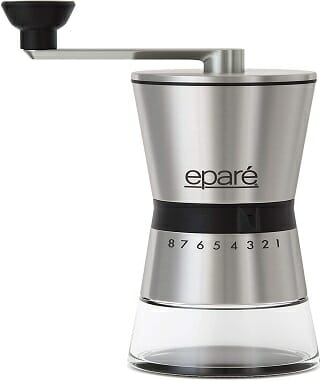
User-friendliness : Hopper is easy to load and the handle is magnetic. No annoying screws. It fits in the hand nicely, and the bottom is adhesive, which makes it a perfect grinder for beginners, or travelers.
It is also a small family-owned company, which I like. Plus, it is backed by Eparé Limited Lifetime Warranty.
11. Lido 3 Manual Coffee Grinder
Weight : 2.96 pounds
Material : BPA-free plastic body, stainless steel jar, rubberized grip. Comes in a neoprene case, with a cleaning brush included. Swiss-made conical steel burrs
Capacity : 70g (3-4 coffees per grind)
Grind settings : 16 settings, indicated with marks. The black line is 0. If you loosen the locking ring by turning it clockwise, it will allow you to turn the adjustment ring counterclockwise (more coarse grind.) Try 2-4 turns clockwise for espresso, 7-9 for drip, 12-14 for percolator. Grind consistency is very good, which is a plus.
Good for : Espresso, Turkish, pour over, drip, percolator
User-friendliness : This portable grinder with a big hopper is on the pricier side and has a learning curve. The manual is pretty easy to understand, though.
Lido 3 is very durable and hard to break, so think of it as an investment. The only minus for me is its aesthetics. Gets the job done but it is not an eye-catcher.
12. Chestnut G1 Manual Coffee Grinder
Weight : 1.71 pounds
Material : Space aluminum and black walnut body, wooden knob. Sharp steel burrs. This grinder won the Reddot Design Award of 2017, which is called the Oscar Award in the designing industry!
Capacity : 30g (2 coffees per grind)
Grind settings : Try medium grind range (around 15–24 clicks from zero — most tight point)
Good for : Anything above 6 grinds. Not suitable for a very fine coffee grind. Word of advice: If you want a very fine grind (for example for Moka pot) go for a coffee grinder with titanium burrs.
User-friendliness : A high-quality, nice-looking manual grinder that feels solid in the hand. Grinding coffee beans is easy thanks to Speed of grind is very fast thanks to large burr diameter. It also scores points for durability, portability, and easy cleaning.
13. HEIHOX Manual Coffee Grinder with Adjustable Setting
Weight : 1.48 pounds
Material : 0 plastic. Heixox conical grinder for coffee is made from food-grade stainless steel and aluminum. The knob is wooden and burr grinders are made from stainless steel.
Capacity : 30g (2 coffees per grind)
Grind settings : As always, it is a trial and error process. First, tighten the dial clockwise all the way up. Second, loosen it “click” at a time.
Good for : Anything from espresso to pour over.
User-friendliness : It is sturdy and heavier. However, the correct coarseness for several levels of coarseness makes it a perfect pairing with Hario V60, which I recommended in my previous article, French press, or Aeropress.
Final Thoughts:
If you want a steel, but light, small, travel-friendly manual coffee grinder, look into 1Zpresso Q2 Manual Coffee Grinder Mini Slim Travel Sized. Another plus of this grinder is that settings are numbered. The second grinder from our list with this feature is Manual Coffee Grinder by Eparé.
If you want a coffee grinder that is the size of a can of Coke, portable, light, yet has ceramic, sharp burrs and fits just perfectly into an Aeropress, go for Porlex Mini Stainless Steel Coffee Grinder.
If you are looking for an easy to clean, easy-to-use grinder for one person, that costs less than 30 dollars and comes with a lifetime warranty, look into Khaw-Fee HG1B Manual Coffee Grinder. Manual Coffee Grinder by Eparé has a limited lifetime warranty, too.
If you love the wooden design and want to avoid ceramic burrs, that can chip, or steel burrs, that can rust, go for the budget-friendly but beautiful Akirakoki Manual Coffee Bean Grinder.
If you are looking for a vintage grinder from a company with history (it was established in 1867) and you are willing to pay more than 100 dollars, go for a German Zassenhaus Santiago Mahogany Coffee Mill Grinder. Just bear in mind that it is harder to put apart and clean.
If you like Hario products, but Hario Skerton looks fragile, go for HEIHOX. It is harder to break, has stainless steel burrs, and is friends with Hario V60.
Editor’s Choice:
There is no much difference in the price of buying pre-ground beans and whole coffee beans. However, the quality and the feeling of accomplishment (even if it will take a bit of trial and error at first) are worth the manual work. Coffee Nirvana awaits!
The best hand manual grinder coffee device for me is 1Zpresso Q2 Manual Coffee Grinder Mini Slim Travel Sized because it’s durable, easy to disassemble, has the best even grind for a manual hand grinder and fits perfectly in the plunger of my Aeropress.
I usually grind (insert grams of coffee) for one cup of coffee. My go-to grind is (insert type of grind) for (insert type of coffee)
How about you? Any coffee grinding tips?
How To Use A Manual Burr Grinder?
I know. Before you buy one you are probably wondering how hard/easy it is to use it.

- Put the manual grinder apart by removing the handle and locking ring. Some machines also have a top nut.
- Turn the adjustment ring clockwise if you’re looking for a finer grind, and counterclockwise if you’re looking for a coarser grind. The way to measure your grind is by bumps or “clicks” away from the tight point. I recommend printing out this handy chart and writing down your results. Some coffee grinders have numbered settings, which makes life easier.
- After you have settled for the setting you want, you can put the locking grind back.
- Then place back the handle and top nut, if your machine has one.
- Measure twice, cut once. Test the grind setting on a small size of beans first. One should double-check one’s measurements for accuracy (and tasty coffee)
- If you made sure it’s what you want, proceed. If you do not like the sample, start from the first step. If you are a beginner, buy cheaper beans to practice on.
- After using a manual coffee grinder, take it apart (from lid to ground catcher, shell, and burrs) and clean it manually, not in a dishwasher. For a grinder with ceramic burrs (that do not rust), you can soak it in a bowl of soapy water to get rid of leftover grounds and oils. You can also use a soft toothbrush, art paintbrush, or a Q Tip to lightly scrub it. Wooden toothpicks are useful to get everything out. To make sure no parts are moist before you assemble your manual grinder back, let them rest on a clean piece of cloth.
- When assembling it back together, make sure that you slide the burr up the rod into the other burr.
- The last tip — if you own your manual grinder for a longer time and have the feeling it could use a deeper clean, get a small screwdriver to put apart even the pieces that hold tight together, or look into grinder cleaning pellets. They look like coffee beans, but they extend the life of your manual grinder. If in doubt, consult the manufacturer directly. Some people even use alternatives, such as corn husks, oatmeal, barley, bulgur, etc. After all, if you look into the cleaning pellet ingredients list, you will find that about 85% of it is of organic origin.

